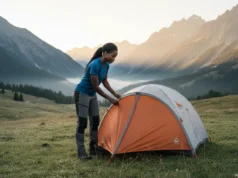In this article
After a grueling ten-mile day, a cold wind picks up and the first drops of a mountain storm begin to fall. While others fumble with color-coded traditional pole tents and tangled guylines, you simply unroll your air tent, connect a pump to its inflatable frame, and watch your sturdy refuge take shape in under two minutes. This isn’t a futuristic fantasy; it’s the reality of modern inflatable tents. While often misunderstood as gimmicks prone to puncture risk, these air-supported shelters, with their robust air beams, offer a revolutionary blend of storm resilience and quick setup speed that can be a game-changer for the right kind of adventure. But choosing the right one requires looking beyond the hype. This buying guide and comparison/review provides a data-driven framework to help you decide if an inflatable camping tent is the right choice for your next mission—from family camping to wild camping—and, if so, exactly which one to trust.
How to Choose the Right Inflatable Camping Tent: An Expert’s Framework
To make a smart, confident choice, you need to move from being a passive consumer to an informed evaluator. This means understanding the core principles that make this tent technology unique. We’ll break down the three critical areas where camping tents inflatable rewrite the rules of shelter performance: storm resilience, packability, and durability.
Why Does Storm Resilience Matter More Than Rigid Strength?
In the mountains, the defining characteristic of a good shelter isn’t brute strength, but the ability to absorb and dissipate energy. The core principle of an inflatable tent is that its air beams are designed to flex under a heavy wind load, absorbing the gust’s energy and then returning to their original shape. In stark contrast, rigid aluminum or fiberglass poles behave like a dry branch; they resist the force up to a point, but once that threshold is crossed, they either permanently bend or catastrophically snap, a trip-ending failure.
The physics of wind are unforgiving; the force exerted on a tent increases with the square of the wind speed. This excellent wind performance, often verified in wind tunnel testing, means a tent that can dissipate that energy is inherently more stable in wind. The potential downside to this flexibility is that excessive movement can cause the rainfly to touch the inner tent, which could lead to moisture transfer from condensation. However, a well-engineered design with a good number of air beams mitigates this with a taught pitch, robust guy lines, and an aerodynamic shape. Understanding how a tent handles a storm is critical, but for many campers, the real challenge begins before the tent is even pitched. This is where balancing weight, interior space, and weather protection connects to the broader challenge of choosing any hiking tent, a concept you can explore further from authoritative sources like slowerhiking.com.
How Does “Trail-Ready Packability” Go Beyond Just Weight?
On the trail, the burden of your tent is not just a number on a scale. True “trail-ready packability” is a holistic measure combining weight, packed size, shape, and compressibility, which we might summarize as a Packability Score. This is where inflatable camping tents present a compelling paradox. While they may be slightly heavier than some ultralight pole tents, their lack of long, rigid pole segments gives them a key advantage. The packed shape is often shorter, wider, and more malleable.
This isn’t just a minor convenience; it fundamentally changes how you pack. A practical example is that an inflatable tent can often be molded into the empty spaces of a backpack, compressed into a pannier, or fit neatly into a bikepacking frame bag where a traditional pole set simply would not go. A long, awkward tent bag can negatively affect a hiker’s balance and comfort far more than a slightly heavier but more compressible air shelter. This ties directly into the broader philosophy of lightweight backpacking, which focuses on strategies to significantly reduce pack base weight by optimizing every piece of gear. As experts at SectionHiker explain, the difference between trail weight and packaged weight is a crucial distinction that experienced backpackers learn to master.
What’s the Real Story on Durability & Field Repairability?
Let’s directly address the primary concern everyone has when considering air tents: the puncture risk. It’s a valid question, but one that needs reframing. The more relevant comparison is between a small, field-repairable puncture—a manageable inconvenience—and a snapped pole, a catastrophic failure. High-end inflatable tents offer excellent puncture resistance. They are built with high-denier, PU-coated polyester or polycotton for the tent body, robust seam sealing, and tough Thermoplastic Polyurethane (TPU) for the air bladders, often protected within reinforced sleeves for better long-term durability.
The repair process itself is straightforward. A small puncture can be fixed in the field with a simple repair kit, which typically includes patches, glue, and tape. A tent that scores highly in this category will include a comprehensive kit and provide easy access to the air beams. To answer the question, “how long do inflatable tents last?,” the key lies in proper care. After camping trips, ensure the tent is clean and completely dry before storage. Regular inspection of the valves and beams is essential for care & maintenance.
Pro-Tip: For a stronger, more reliable field repair on a TPU air beam, always carry a few small alcohol prep pads in your patch kit. Cleaning the area around the puncture with an alcohol pad removes any dirt or oils and ensures the adhesive on the patch creates a permanent, airtight bond.
Our Selection Process: How We Built This Guide
Our commitment is to objectivity. This guide is not a random list of products. It’s the result of expert-tested reviews and systematic analysis designed to serve one purpose: to help you make an informed decision. Every tent we considered was judged against critical, hiker-centric performance criteria: Trail-Ready Packability, Storm Resilience, Livability, Durability & Repairability, and Setup Efficiency. We created a Trail Readiness Matrix to score each model on these trail-specific attributes. Our process involved comparing features, analyzing customer reviews, and conducting our own field testing. We filtered that database through the lens of distinct user personas, ensuring each recommendation is the right tent for a specific mission, whether it’s car camping, an ultralight mission, or setting up alpine basecamps.
A Note on Affiliate Links: If you choose to purchase a product through a link on this page, we may earn a small commission at no extra cost to you. This helps support our work, but our recommendations are, and always will be, driven by our independent research and analysis.
The Best Inflatable Camping Tents of 2025: Our Top Recommendations for Every Need
Here we present our curated top recommendations, matching the best inflatable tent technology to the key user personas we identified. This isn’t about finding a single “best inflatable tent,” but empowering you to find the perfect match for your specific needs.
Our Top Picks for The Ultralight Thru-Hiker / Bikepacker
This user prioritizes minimal weight and maximum compressibility above all else for missions like solo wild camping or multi-day thru-hikes. Their shelter is a tool for recovery, not a destination for recreation. Every gram matters. For them, a shelter’s value is measured by how little it burdens them on the move.
Our Top Picks for The Alpine Basecamper / Expeditionist
This user operates in high-consequence environments where their shelter is a critical piece of survival equipment. For them, a tent is a lifeline for group basecamps. Absolute security, storm resilience, and durability are paramount, and they understand that true safety in the alpine means accepting the heavy weight penalty that comes with a robust inflatable shelter.
Our Top Picks for The Overlanding Adventurer / Vehicle-Supported Trekker
This user utilizes a vehicle as a mobile base of operations. Their tent is an extension of that vehicle, prioritizing convenience, comfort, and the speed of deployment over concerns like weight and pack size. They need a shelter for their overlanding rig that can be set up and taken down in minutes during weekend getaways, allowing for maximum time exploring.
Pro-Tip: When using a vehicle-supported tent like a rooftop tent (RTT) or an awning shelter, always park your vehicle so the largest, strongest part of the tent faces into the prevailing wind. This uses the vehicle itself as a windbreak and presents the most aerodynamic profile to gusts, dramatically increasing stability.
Conclusion
The evidence is clear: modern inflatable tents have moved far beyond the gimmick perception. This air tent technology provides superior storm resilience by flexing to absorb wind where traditional poles would snap. Their unique packability—a combination of weight, volume, and shape—gives them a significant advantage for space-conscious users like backpackers and bikepackers. And while the risk of a puncture is real, it is often a far more manageable field repair than a broken pole. Ultimately, the best inflatable tent is not a one-size-fits-all solution. Your choice should be driven by your primary activity, whether that’s ultralight thru-hiking, setting up an expedition basecamp, or overlanding.
Armed with the right framework, you can now confidently choose an inflatable shelter that matches your adventure. Explore our top picks, and get ready to experience the revolutionary speed and stability on your next camp trip.
Frequently Asked Questions about Inflatable Camping Tents
Are inflatable tents actually good in high winds?
Yes, and to answer “are inflatable tents good in wind” more fully, they are often better than pole tents. Their flexible inflatable beams are designed to bend and absorb energy from gusts rather than snapping. A model with a well-designed, aerodynamic shape and a geodesic inflatable frame, like the Heimplanet Fistral, can provide exceptional and reliable stability in severe weather, a key measure of weather resistance.
Can you repair a punctured inflatable tent in the field?
Absolutely. To answer “how do you repair,” a small puncture in an air beam can typically be fixed in minutes using a simple repair kit. The process usually involves locating the hole, cleaning the surface, and applying an adhesive patch. This makes a potential puncture a manageable inconvenience rather than a trip-ending failure.
Are inflatable tents too heavy for backpacking?
While many large tents, like the Berghaus Air 6XL Nightfall, are very heavy, there are excellent ultralight models designed for backpacking. For example, the Alpkit Aeronaut 2 has a trail weight of only 1.5 kg, making it highly competitive with traditional pole tents in terms of weight and far superior in packability.
Do inflatable tents come with a pump?
Most inflatable tents can be inflated with a high-volume manual pump, which is often included. Some ultralight models are even bike pump compatible. Many larger family camping tents, like the Coleman Weathermaster 6XL, may come with a 12V electric pump for maximum easy setup, though this creates a pump dependency on a power source.
Risk Disclaimer: Hiking, trekking, backpacking, and all related outdoor activities involve inherent risks which may result in serious injury, illness, or death. The information provided on The Hiking Tribe is for educational and informational purposes only. While we strive for accuracy, information on trails, gear, techniques, and safety is not a substitute for your own best judgment and thorough preparation. Trail conditions, weather, and other environmental factors change rapidly and may differ from what is described on this site. Always check with official sources like park services for the most current alerts and conditions. Never undertake a hike beyond your abilities and always be prepared for the unexpected. By using this website, you agree that you are solely responsible for your own safety. Any reliance you place on our content is strictly at your own risk, and you assume all liability for your actions and decisions in the outdoors. The Hiking Tribe and its authors will not be held liable for any injury, damage, or loss sustained in connection with the use of the information herein.
Affiliate Disclosure: We are a participant in the Amazon Services LLC Associates Program, an affiliate advertising program designed to provide a means for us to earn advertising fees by advertising and linking to Amazon.com. As an Amazon Associate, we earn from qualifying purchases. We also participate in other affiliate programs and may receive a commission on products purchased through our links, at no extra cost to you. Additional terms are found in the terms of service.





